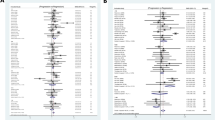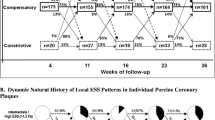Abstract
Purpose of Review
Atherosclerosis has major morbidity and mortality implications globally. While it has often been considered an irreversible degenerative process, recent evidence provides compelling proof that atherosclerosis can be reversed. Plaque regression is however difficult to appraise and quantify, with competing diagnostic methods available. Given the potential of evidence synthesis to provide clinical guidance, we aimed to review recent meta-analyses on diagnostic methods for atherosclerotic plaque regression.
Recent Findings
We identified 8 meta-analyses published between 2015 and 2017, including 79 studies and 14,442 patients, followed for a median of 12 months. They reported on atherosclerotic plaque regression appraised with carotid duplex ultrasound, coronary computed tomography, carotid magnetic resonance, coronary intravascular ultrasound, and coronary optical coherence tomography. Overall, all meta-analyses showed significant atherosclerotic plaque regression with lipid-lowering therapy, with the most notable effects on echogenicity, lipid-rich necrotic core volume, wall/plaque volume, dense calcium volume, and fibrous cap thickness. Significant interactions were found with concomitant changes in low density lipoprotein cholesterol, high density lipoprotein cholesterol, and C-reactive protein levels, and with ethnicity.
Summary
Atherosclerotic plaque regression and conversion to a stable phenotype is possible with intensive medical therapy and can be demonstrated in patients using a variety of non-invasive and invasive imaging modalities.

Similar content being viewed by others
References
Papers of particular interest, published recently, have been highlighted as: • Of importance •• Of major importance
Falk E. Plaque rupture with severe pre-existing stenosis precipitating coronary thrombosis: characteristics of coronary atherosclerotic plaques underlying fatal occlusive thrombi. Br Heart J. 1983;50:127e34.
Frink RJ. Chronic ulcerated plaques: new insights into the pathogenesis of acute coronary disease. J Invasive Cardiol. 1994;6:173e85.
Fuster V, Lewis A. Conner memorial lecture. Mechanisms leading to myocardial infarction: insights from studies of vascular biology. Circulation. 1994;90(4):2126–46. https://doi.org/10.1161/01.CIR.90.4.2126.
Spence JD. The role of lipoprotein(a) in the formation of arterial plaques, stenoses and occlusions. Can J Cardiol. 2010;26:37A–40A. https://doi.org/10.1016/S0828-282X(10)71060-6.
Topol EJ, Nissen SE. Our preoccupation with coronary luminology. The dissociation between clinical and angiographic findings in ischemic heart disease. Circulation. 1995;92(8):2333–42. https://doi.org/10.1161/01.CIR.92.8.2333.
Hibi K, Kimura T, Kimura K, Morimoto T, Hiro T, Miyauchi K, et al. Clinically evident polyvascular disease and regression of coronary atherosclerosis after intensive statin therapy in patients with acute coronary syndrome: serial intravascular ultrasound from the Japanese assessment of pitavastatin and atorvastatin in acute coronary syndrome (JAPAN-ACS) trial. Atherosclerosis. 2011;219(2):743-9. https://doi.org/10.1016/j.atherosclerosis.2011.08.024.
Brown BG, Zhao XQ. Lipid-lowering therapy. In: Hennekens CH, editor. Clinical trials in cardiovascular disease (a companion to Braunwald’s heart disease). Philadelphia: WB Saunders; 1999. p. 199e216.
Kamal-Bahl SJ, Burke T, Watson D, Wentworth C. Discontinuation of lipid modifying drugs among commercially insured United States patients in recent clinical practice. Am J Cardiol. 2007;99:530e4.
Worthley SG, Helft G, Fuster V, Zaman AG, Fayad ZA, Fallon JT, et al. Serial in vivo MRI documents arterial remodeling in experimental atherosclerosis. Circulation. 2000;101(6):586–9. https://doi.org/10.1161/01.CIR.101.6.586.
Di Vito L, Imola F, Gatto L, Romagnoli E, Limbruno U, Marco V, et al. Limitations of OCT in identifying and quantifying lipid components: an in vivo comparison study with IVUS-NIRS. EuroIntervention. 2017;13(3):303–11. https://doi.org/10.4244/EIJ-D-16-00317.
Nicholls SJ, Puri R, Anderson T, Ballantyne CM, Cho L, Kastelein JJ, et al. Effect of evolocumab on progression of coronary disease in statin-treated patients: the GLAGOV randomized clinical trial. JAMA. 2016;316(22):2373–84. https://doi.org/10.1001/jama.2016.16951.
Kataoka Y, Uno K, Puri R, Nicholls SJ. Current imaging modalities for atherosclerosis. Expert Rev Cardiovasc Ther. 2012;10(4):457–71. https://doi.org/10.1586/erc.12.28.
Biondi-Zoccai G, editor. Network meta-analysis: evidence synthesis with mixed treatment comparison. Hauppauge: Nova Science Publishers; 2014.
•• Biondi-Zoccai G, editor. Umbrella reviews. Evidence synthesis with overviews of reviews and meta-epidemiologic studies. Cham: Springer International; 2016. This book provides a comprehensive guidance for clinicians and researchers interested in umbrella reviews, overviews of reviews, and meta-epidemiologic studies.
Brinjikji W, Lehman VT, Kallmes DF, Rabinstein AA, Lanzino G, Murad MH, et al. The effects of statin therapy on carotid plaque composition and volume: a systematic review and meta-analysis. J Neuroradiol. 2017;44(4):234–40. https://doi.org/10.1016/j.neurad.2016.12.004.
•• Ibrahimi P, Jashari F, Bajraktari G, Wester P, Henein MY. Ultrasound assessment of carotid plaque echogenicity response to statin therapy: a systematic review and meta-analysis. Int J Mol Sci. 2015;16(5):10734–47. This meta-analysis shows a significant interaction between changes in levels of in low-density lipoprotein cholesterol, high-density lipoprotein cholesterol, and C-reactive protein and the benefits of statins on atherosclerotic plaque regression. https://doi.org/10.3390/ijms160510734.
• Li YF, Feng QZ, Gao WQ, Zhang XJ, Huang Y, Chen YD. The difference between Asian and Western in the effect of LDL-C lowering therapy on coronary atherosclerotic plaque: a meta-analysis report. BMC Cardiovasc Disord. 2015;15(1):6. This meta-analysis shows that Asian patients seem to require less dramatic changes in low-density lipoprotein cholesterol levels to achieve similar changes in plaque burden in comparison to Western patients. https://doi.org/10.1186/1471-2261-15-6.
Puri R, Nissen SE, Shao M, Kataoka Y, Uno K, Kapadia SR, et al. The beneficial effects of raising high-density lipoprotein cholesterol depends upon achieved levels of low-density lipoprotein cholesterol during statin therapy: implications for coronary atheroma progression and cardiovascular events. Eur J Prev Cardiol. 2016;23(5):474–85. https://doi.org/10.1177/2047487315572920.
• Qian C, Wei B, Ding J, Wu H, Cai X, Li B, et al. Meta-analysis comparing the effects of rosuvastatin versus atorvastatin on regression of coronary atherosclerotic plaques. Am J Cardiol. 2015;116(10):1521–6. This meta-analysis shows that rosuvastatin seems superior to atorvastatin in terms of atherosclerotic plaque regression. https://doi.org/10.1016/j.amjcard.2015.08.010.
Tang X, Yang Y, Luo S, Zhao Y, Lu C, Luo Y, et al. The effect of statin therapy on plaque regression following acute coronary syndrome: a meta-analysis of prospective trials. Coron Artery Dis. 2016;27(8):636–49. https://doi.org/10.1097/MCA.0000000000000403.
Zheng G, Chen J, Lin C, Huang X, Lin J. Effect of statin therapy on fibrous cap thickness in coronary plaques using optical coherence tomography: a systematic review and meta-analysis. J Interv Cardiol. 2015;28(6):514–22. https://doi.org/10.1111/joic.12245.
Zheng G, Li Y, Huang H, Wang J, Hirayama A, Lin J. The effect of statin therapy on coronary plaque composition using virtual histology intravascular ultrasound: a meta-analysis. PLoS One. 2015;10(7):e0133433. https://doi.org/10.1371/journal.pone.0133433.
Yusuf S, Hawken S, Ounpuu S, Dans T, Avezum A, Lanas F, et al. Effect of potentially modifiable risk factors associated with myocardial infarction in 52 countries (the INTERHEART study): case-control study. Lancet. 2004;364(9438):937–52. https://doi.org/10.1016/S0140-6736(04)17018-9.
Feig JE, Feig JL, Dangas GD. The role of HDL in plaque stabilization and regression: basic mechanisms and clinical implications. Coron Artery Dis. 2016;27(7):592–603. https://doi.org/10.1097/MCA.0000000000000408.
Lipinski MJ, Benedetto U, Escarcega RO, Biondi-Zoccai G, Lhermusier T, Baker NC, et al. The impact of proprotein convertase subtilisin-kexin type 9 serine protease inhibitors on lipid levels and outcomes in patients with primary hypercholesterolaemia: a network meta-analysis. Eur Heart J. 2016;37(6):536–45. https://doi.org/10.1093/eurheartj/ehv563.
• Ridker PM, Everett BM, Thuren T, Mac Fadyen JG, Chang WH, Ballantyne C, et al. Antiinflammatory therapy with canakinumab for atherosclerotic disease. N Engl J Med. 2017;377(12):1119–31. This randomized trials shows that long-term anti-interleukin-1 therapy reduces the risk of recurrent atherothrombotic events after myocardial infarction. https://doi.org/10.1056/NEJMoa1707914.
Biondi-Zoccai GG, Abbate A, Liuzzo G, Biasucci LM. Atherothrombosis, inflammation, and diabetes. J Am Coll Cardiol. 2003;41(7):1071–7. https://doi.org/10.1016/S0735-1097(03)00088-3.
Author information
Authors and Affiliations
Corresponding author
Ethics declarations
Conflict of Interest
Simona Mastrangeli, Enrico Romagnoli, Mariangela Peruzzi, Giacomo Frati, Leonardo Roever, and Arturo Giordano declare no conflict of interest. Prof. Biondi-Zoccai has consulted for Abbott Vascular and Bayer.
Human and Animal Rights and Informed Consent
This article does not contain any studies with human or animal subjects performed by any of the authors.
Additional information
This article is part of the Topical Collection on Evidence-Based Medicine
Rights and permissions
About this article
Cite this article
Biondi-Zoccai, G., Mastrangeli, S., Romagnoli, E. et al. What We Have Learned from the Recent Meta-analyses on Diagnostic Methods for Atherosclerotic Plaque Regression. Curr Atheroscler Rep 20, 2 (2018). https://doi.org/10.1007/s11883-018-0709-y
Published:
DOI: https://doi.org/10.1007/s11883-018-0709-y




